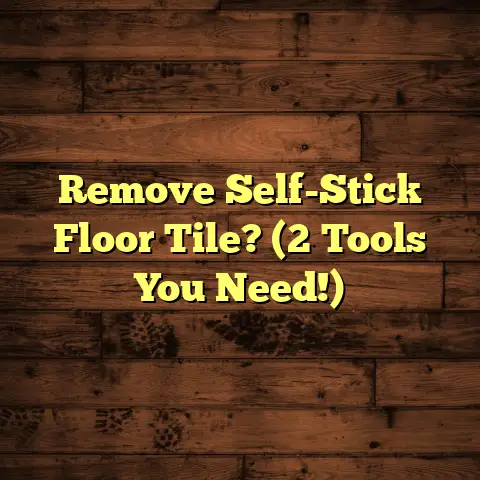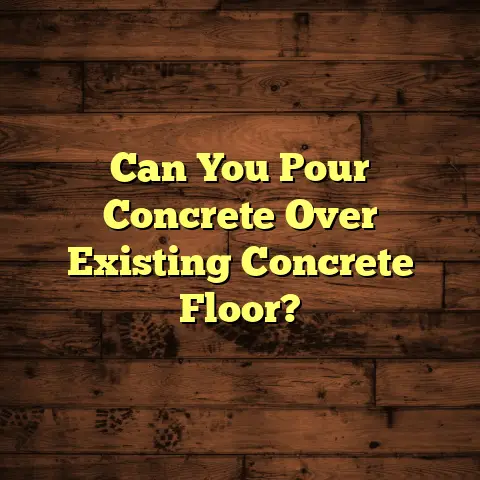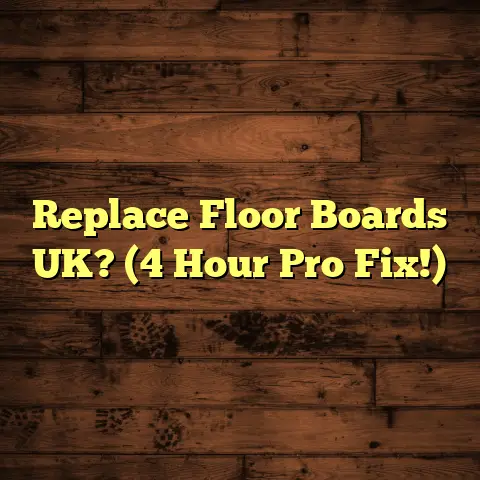Wood Over Concrete? (10 Install Tips!)
The Uniqueness of Wood Flooring Over Concrete
Let’s face it, concrete can be a bit, well, cold. Literally and figuratively. It’s durable, sure, but it lacks that certain je ne sais quoi that makes a house feel like a home.
That’s where wood flooring swoops in like a superhero. It brings warmth, character, and a touch of elegance to any space. Whether you’re rocking a modern minimalist vibe or leaning into classic traditional charm, wood flooring is incredibly versatile.
I’ve seen concrete basements transformed into cozy living rooms, and stark urban apartments turned into inviting sanctuaries, all thanks to the magic of wood. And guess what? More and more people are catching on!
Installing wood over concrete is a trend that’s here to stay. It’s a fantastic way to combat the cold, hard reality of concrete and inject some much-needed warmth and style into your living space.
So, you’re thinking about taking the plunge? Awesome! But before you grab your hammer and nails (or glue, depending on your method), let’s dive into 10 essential installation tips that will help you achieve a flawless finish. Trust me, these are the lessons I’ve learned the hard way over years of installing floors, and I’m happy to share them with you.
10 Essential Installation Tips
1. Choose the Right Type of Wood Flooring
Okay, first things first: not all wood flooring is created equal, especially when it comes to concrete. You’ve got solid hardwood, engineered wood, and laminate, each with its own pros and cons.
-
Solid Hardwood: Beautiful, classic, but… not ideal for concrete. Solid wood is susceptible to moisture, and concrete, as you might know, can be a moisture magnet. I generally advise against using it directly over concrete unless you have a perfectly dry slab and a robust moisture barrier system.
-
Engineered Wood: This is my go-to for concrete installations. Engineered wood is made of multiple layers of wood veneer glued together, making it more stable and less prone to warping or cupping due to moisture. Plus, it looks just as good as solid wood! Think of it as the more practical, less temperamental cousin of solid hardwood.
-
Laminate: A budget-friendly option that mimics the look of wood. It’s durable and easy to clean, but it doesn’t have the same warmth and feel as real wood. While it can be installed over concrete, it’s crucial to use a good quality underlayment with a built-in moisture barrier.
My recommendation? Engineered wood is your best bet for balancing aesthetics, durability, and moisture resistance.
2. Conduct a Moisture Test
This is HUGE. I can’t stress this enough: never skip the moisture test! Concrete is porous and can wick up moisture from the ground, which can wreak havoc on your wood floor.
So, how do you test for moisture? Here are a couple of methods:
-
Calcium Chloride Test (ASTM F1869): This is the gold standard. You place a pre-weighed dish of calcium chloride on the concrete, seal it with a dome, and leave it for 60-72 hours. Then, you weigh it again. The weight gain indicates the amount of moisture the concrete is releasing.
-
Relative Humidity (RH) Test (ASTM F2170): This involves drilling small holes into the concrete and inserting probes that measure the humidity levels inside the slab.
-
Moisture Meter: While not as accurate as the above, a moisture meter can give you a quick indication of surface moisture. Just be sure to use a meter specifically designed for concrete.
What are acceptable moisture levels? It depends on the type of flooring you’re using, but generally:
- Calcium Chloride Test: Less than 3 lbs of moisture emitted per 1,000 square feet in 24 hours.
- Relative Humidity Test: Less than 75% RH.
If your concrete exceeds these levels, you’ll need to address the moisture issue before installing your wood floor. This might involve applying a moisture barrier or even installing a subfloor with a built-in vapor retarder.
I’ve seen too many beautiful floors ruined by neglecting this step. Don’t let that happen to you!
3. Prepare the Concrete Surface
Alright, your moisture test came back clear (or you’ve addressed the moisture issue). Now it’s time to prep the concrete.
Here’s what you need to do:
-
Clean: Sweep, vacuum, and scrub the concrete to remove any dirt, dust, debris, or old adhesive. I like to use a concrete cleaner to get rid of any stubborn stains or grease.
-
Level: Concrete isn’t always perfectly level. Use a long level (at least 6 feet) to identify any high or low spots. For minor imperfections (less than 1/4 inch over 10 feet), you can use a self-leveling compound. For larger dips or humps, you might need to grind down the high spots or use a concrete patching compound to fill in the low areas.
-
Repair Cracks: Fill any cracks or holes with a concrete patching compound. Even small cracks can cause problems down the road, so it’s best to address them now.
A smooth, clean, and level surface is essential for a successful wood floor installation. It ensures that your flooring will lay flat and won’t have any annoying squeaks or uneven spots.
4. Consider the Underlayment
Underlayment is your floor’s best friend when it comes to concrete. It provides a cushion, reduces noise, and, most importantly, acts as a moisture barrier.
There are several types of underlayment available:
-
Foam: A common and affordable option. It provides good cushioning and sound absorption. Look for foam underlayment with a built-in moisture barrier.
-
Cork: A natural and sustainable choice. Cork is excellent for sound insulation and provides a comfortable feel underfoot. It’s also naturally resistant to mold and mildew.
-
Rubber: Offers superior sound and impact absorption. It’s a great choice for multi-story buildings or areas with high foot traffic.
How do you choose the right underlayment? Consider these factors:
- Moisture Protection: If your concrete is prone to moisture, choose an underlayment with a vapor barrier.
- Sound Insulation: If you want to reduce noise, opt for a thicker underlayment with a high sound transmission class (STC) rating.
- Comfort: If you want a softer feel underfoot, choose a thicker underlayment with good cushioning.
I often recommend a high-quality foam underlayment with a built-in moisture barrier for most residential applications. It’s a good balance of cost, performance, and ease of installation.
5. Acclimate the Wood
Okay, you’ve chosen your flooring, tested for moisture, prepped the concrete, and picked out your underlayment. Now, before you start laying those planks, you must acclimate the wood.
What does that mean? It means allowing the wood to adjust to the temperature and humidity of your home before installation. Wood is a natural material and will expand and contract with changes in its environment. If you install it before it’s had a chance to acclimate, you could end up with gaps, warping, or buckling down the road.
Here’s how to acclimate your wood flooring:
- Bring the wood into the room where it will be installed.
- Stack the boxes of flooring in a way that allows for air circulation. Don’t stack them directly against the wall.
- Leave the wood to acclimate for at least 3-5 days, or longer if the humidity levels are significantly different from the wood’s previous environment.
I know, waiting is the hardest part, but trust me, it’s worth it. Acclimation is like insurance for your floor. It’s a small investment of time that can save you a lot of headaches (and money) later on.
6. Plan Your Layout
Before you start slapping down planks, take some time to plan your layout. This will help you avoid awkward cuts, uneven rows, and wasted material.
Here are a few things to consider:
-
Direction: Which way do you want the planks to run? Generally, running the planks parallel to the longest wall can make a room feel larger. You can also run them perpendicular to the joists for added support.
-
Starting Point: Where will you start laying the flooring? I usually recommend starting along a straight wall and working your way out from there.
-
Obstacles: How will you handle doorways, corners, and other obstacles? Plan your cuts in advance to minimize waste and ensure a clean, professional look.
-
Staggering: Stagger the end joints of the planks to create a more visually appealing and structurally sound floor. I recommend a minimum stagger of 6 inches.
A well-planned layout can make a huge difference in the final look and feel of your floor. It’s like sketching out a painting before you start applying the paint. It helps you visualize the end result and avoid costly mistakes.
7. Use the Right Tools and Materials
Okay, you’ve got your plan, your wood is acclimated, and you’re ready to roll. But before you start, make sure you have the right tools and materials.
Here’s a basic checklist:
- Saw: A circular saw or miter saw for cutting planks.
- Nail Gun (for nailing installations): A flooring nailer is ideal, but a finish nailer can also work.
- Tapping Block and Mallet (for floating installations): To help you lock the planks together without damaging them.
- Spacers: To maintain consistent expansion gaps around the perimeter of the room.
- Measuring Tape, Pencil, and Square: For accurate measurements and cuts.
- Adhesive (for gluing installations): Use a high-quality adhesive specifically designed for wood flooring.
- Safety Glasses and Knee Pads: Safety first!
Using the right tools and materials will make the installation process much easier and ensure a better-quality result. Don’t skimp on this step. Invest in good tools and materials, and they’ll pay for themselves in the long run.
8. Installation Techniques
There are three main methods for installing wood flooring over concrete:
-
Nailing: This involves nailing the wood planks directly to a wooden subfloor that’s been installed over the concrete. This method is typically used with solid hardwood flooring and requires a significant amount of prep work.
-
Gluing: This involves gluing the wood planks directly to the concrete slab using a special adhesive. This method is commonly used with engineered wood flooring and provides a very stable and durable installation.
-
Floating: This involves laying the wood planks over an underlayment without attaching them to the concrete. The planks are typically joined together using a tongue-and-groove system. This method is popular for its ease of installation and is often used with laminate and some types of engineered wood flooring.
Which method is best for concrete?
In my experience, gluing or floating are the most practical options for installing wood over concrete. Nailing requires a wooden subfloor, which can add extra cost and complexity to the project.
If you choose to glue, be sure to use a high-quality adhesive specifically designed for wood flooring and follow the manufacturer’s instructions carefully. If you choose to float, make sure your underlayment provides adequate moisture protection and sound insulation.
9. Leave Expansion Gaps
I mentioned this earlier, but it’s worth repeating: always leave expansion gaps around the perimeter of the room and at thresholds.
Wood expands and contracts with changes in temperature and humidity. If you don’t leave enough space for this natural movement, the flooring can buckle, warp, or even crack.
I recommend leaving a gap of at least 1/4 inch (6mm) around the entire perimeter of the room. You can use spacers to maintain consistent gaps during installation.
Once the flooring is installed, you can cover the expansion gaps with baseboards or quarter-round molding. This will give your floor a clean, finished look while still allowing for expansion and contraction.
10. Finishing Touches
You’re almost there! You’ve installed your wood floor, and it looks amazing. Now it’s time for the finishing touches.
Here are a few things to do:
- Clean: Sweep, vacuum, and mop the floor to remove any dust, debris, or adhesive residue. Use a cleaner specifically designed for wood floors.
- Install Baseboards: Install baseboards or quarter-round molding to cover the expansion gaps and give your floor a finished look.
- Protect: Place felt pads under furniture legs to prevent scratches and dents.
- Maintain: Follow the manufacturer’s instructions for cleaning and maintaining your wood floor. Regular cleaning and maintenance will help keep your floor looking its best for years to come.
A Beautiful Transformation Awaits
So, there you have it: 10 essential installation tips for laying wood flooring over concrete. It might seem like a lot of work, but trust me, the results are worth it.
With careful planning, attention to detail, and a little bit of elbow grease, you can transform a cold, drab concrete slab into a warm, inviting space that you’ll love for years to come.
Don’t be afraid to take the plunge! With the knowledge and tips I’ve shared with you today, you’re well on your way to achieving a stunning wood floor transformation.
Happy flooring!





